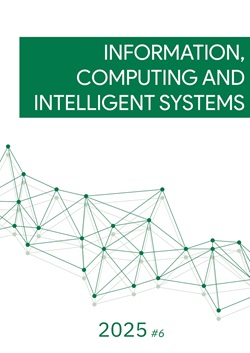Hybrid Path Planning Method for Unmanned Ground Vehicles Swarm in Dynamic Environments
DOI:
https://doi.org/10.20535/2786-8729.6.2025.333730Keywords:
unmanned ground vehicles, A* algorithm, artificial potential field algorithm, dynamic environment, autonomous swarm navigationAbstract
Unmanned ground vehicles (UGVs) have significant potential across various applications. These include automation of the agricultural tasks, inspection and maintenance within construction and industrial sectors, automation of complex assembly processes and infrastructure repairs, explosives disposal, automation of logistical operations, search-and-rescue missions, and expeditions to hard-to-reach or hazardous areas. However, a key challenge limiting their widespread deployment is autonomous navigation, which remains a significant problem due to dynamic environments characterized by constantly changing obstacle configurations, unpredictable scenarios, and the need for rapid real-time decision-making to ensure safe and stable movement.
The object of this paper is a hybrid path planning for the autonomous navigation of unmanned ground vehicles swarm within a simulated environment. The research aims to develop autonomous navigation method for the unmanned ground vehicles swarm by employing a hybrid approach designed to enhance the efficiency of obstacle avoidance and improve the adaptability to dynamic environments.
To achieve this goal, a novel autonomous swarm navigation method based on a hybrid approach is proposed. This approach differs from existing solutions by employing the A* path planning algorithm with incorporated traversal costs on the map for global-level navigation and the artificial potential field (APF) algorithm, that supports linear and V-shaped formations for local-level navigation.
The research findings indicate that the proposed method allows the swarm to perform optimal path planning, considering traversal costs, and effectively avoid local minimum problems that are inherent to the artificial potential field method. The successful performance of the method within the simulated environment demonstrates its potential for future validation in real-world scenarios and practical applications involving swarms of unmanned ground vehicles operating in challenging environments. At the same time, the study identified challenges related to swarm size scalability in narrow spaces, defining directions for further improvements.
References
V. Kumar, S. Dolma, and N. Fatima, “An Autonomous Unmanned Ground Vehicle: A Technology Driven Approach for Spraying Agrochemicals in Agricultural Crops,” Environment and Ecology, vol. 42, no. 3, pp. 1069–1078, Jul. 2024. https://doi.org/10.60151/envec/LBMW6544.
S. Halder and K. Afsari, “Robots in Inspection and Monitoring of Buildings and Infrastructure: A Systematic Review,” Applied Sciences, vol. 13, no. 4, p. 2304, Feb. 2023. https://doi.org/10.3390/app13042304.
V. S. Panwar et al., “A Review on Design and Characteristics of Landmine Detection Robot,” Evergreen, vol. 11, no. 2, pp. 900–912, Jun. 2024. https://doi.org/10.5109/7183373.
A. De Maio, G. Ghiani, D. Laganà, and E. Manni, “Sustainable last-mile distribution with autonomous delivery robots and public transportation,” Transportation Research Part C: Emerging Technologies, vol. 163, p. 104615, Jun. 2024. https://doi.org/10.1016/j.trc.2024.104615.
S. Beycimen, D. Ignatyev, and A. Zolotas, “A comprehensive survey of unmanned ground vehicle terrain traversability for unstructured environments and sensor technology insights,” Engineering Science and Technology, an International Journal, vol. 47, p. 101457, Nov. 2023. https://doi.org/10.1016/j.jestch.2023.101457.
Y. Tang, M. A. Zakaria, and M. Younas, “Path Planning Trends for Autonomous Mobile Robot Navigation: A Review,” Sensors, vol. 25, no. 4, p. 1206, Feb. 2025. https://doi.org/10.3390/s25041206.
I. A. Holovatenko and A. V. Pysarenko, “Method of route planning in autonomous logistics cyberphysical systems using artificial intelligence,” Visnyk of Kherson National Technical University, vol. 87, no. 4, pp. 230–243, Jan. 2024. https://doi.org/10.35546/kntu2078-4481.2023.4.27.
A. Bozzi, S. Graffione, J.-F. Jimenez, R. Sacile, and E. Zero, “A Platoon-Based Approach for AGV Scheduling and Trajectory Planning in Fully Automated Production Systems,” IEEE Transactions on Industrial Informatics, vol. 21, no. 1, pp. 594–603, Jan. 2025. https://doi.org/10.1109/tii.2024.3455413.
M. Baziyad, T. Rabie, R. Fareh, I. Kamel, and M. Bettayeb, “Exploiting Fluid Dynamics Concepts to Solve Local Minima Problems in Robotic Path Planning,” Procedia Computer Science, vol. 251, pp. 232–239, Oct. 2024. https://doi.org/10.1016/j.procs.2024.11.105.
Y. Duan, C. Yang, J. Zhu, Y. Meng, and X. Liu, “Active obstacle avoidance method of autonomous vehicle based on improved artificial potential field,” International Journal of Advanced Robotic Systems, vol. 19, no. 4, Jul. 2022. https://doi.org/10.1177/17298806221115984.
S. Fan, J. Jiao, P. Lin, and Q. Meng, “Hierarchical formation control technology for multiple autonomous underwater vehicles,” IET Smart Grid, vol. 8, no. 1, Jan. 2025. https://doi.org/10.1049/stg2.12209.
X. Meng and X. Fang, “A UGV Path Planning Algorithm Based on Improved A* with Improved Artificial Potential Field,” Electronics, vol. 13, no. 5, p. 972, Mar. 2024. https://doi.org/10.3390/electronics13050972.




